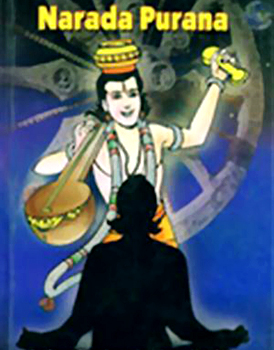 Each story in Narada Purana has a common message that of achieving spirit emancipation and ways of doing so. The religious stories are mainly related to planetary kings. It talks about various birth incarnations trailed by philosophical and dharma stories thereby leading to legends related to some pilgrimages. Thereafter comes the tales of vratas and biography of Suka
Each story in Narada Purana has a common message that of achieving spirit emancipation and ways of doing so. The religious stories are mainly related to planetary kings. It talks about various birth incarnations trailed by philosophical and dharma stories thereby leading to legends related to some pilgrimages. Thereafter comes the tales of vratas and biography of Suka
The religious stories revolve around Lord Vishnu. The tale initially is that of Lunar King Sumati .In Kreta Yuga, king Sumati of the lunar dynasty and his wife Satyamati worshipped Lord Vishnu and on every Dvadas day hoisted a flag in a Vishnu temple. Once when sage Vibhandaka visited them, Sumati narrated to him the story of his previous birth. He was a Shudra by caste, named Malini. Once, while wandering in the forest, he took shelter in a dilapidated Vishnu temple and happily lived there with Avakokila, for ten years. The merit of their stay in Vishnu temple helped them reach Vaikuntha in the end.
Then a story of two brothers Yajnamali and Sumali is narrated. They both shared their paternal property. Sumali wanted his share but as well as what he borrowed from his brother. Therefore Yajnamali was taken to Vaikuntha. Sumali was punished by Yamadutas, So, he enquired from the Vishnudutas about the ways and means which would relieve Sumali of his sins. In the end both the brothers reach heaven as Sumali also compensates for his sins.
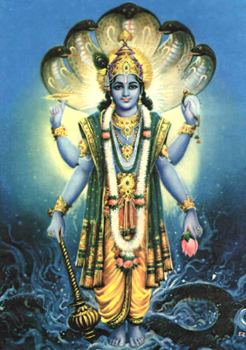 A yajna was performed in Gautamasrama where all the Gods, Brahmanas, kings and demons had assembled. Gautama worshipped Lord Shankara in the linga on the Mt.Tryambaka; all those who were present celebrated it. Sankaratma, a devotee of Siva and the disciple of Gautama, came there and began to dance like a mad man. He ate some food from Gautama`s plate, and while taking meals, passed urine inside the room. So, Gautama placed him on the proper seat and continued his meals. Sankaratma approached Vasaparvan and started dancing. Vasaparvan cut off his head as he was furious seeing his deeds. Gautama suddenly felt heart-broken and died. Many others, present there, followed the same fate. Shiva reached Gautamasrama along with Brahma and Vishnu and revived Gautama. At Gautama`s request, Siva put a fraction of his own soul into Sankaratman`s body to make him immortal. Thereafter Sankaratma was called Hanuman. In the evening he went to the bank of a river and took the Shivalinga for offering bath, when he found it to be without pitha. Being scared he praised Shiva by reciting Rudra-mantra. He smashed it on the ground when he did not notice Shiva in front of him. Virabhadra had come there and on seeing the Shiva linga without its pitha instigated the destruction of world. The sages chanted Veda mantras to please Siva and he appeared before them. Hanuman paid tribute to Siva and he was sent to serve Ram Chandra.
A yajna was performed in Gautamasrama where all the Gods, Brahmanas, kings and demons had assembled. Gautama worshipped Lord Shankara in the linga on the Mt.Tryambaka; all those who were present celebrated it. Sankaratma, a devotee of Siva and the disciple of Gautama, came there and began to dance like a mad man. He ate some food from Gautama`s plate, and while taking meals, passed urine inside the room. So, Gautama placed him on the proper seat and continued his meals. Sankaratma approached Vasaparvan and started dancing. Vasaparvan cut off his head as he was furious seeing his deeds. Gautama suddenly felt heart-broken and died. Many others, present there, followed the same fate. Shiva reached Gautamasrama along with Brahma and Vishnu and revived Gautama. At Gautama`s request, Siva put a fraction of his own soul into Sankaratman`s body to make him immortal. Thereafter Sankaratma was called Hanuman. In the evening he went to the bank of a river and took the Shivalinga for offering bath, when he found it to be without pitha. Being scared he praised Shiva by reciting Rudra-mantra. He smashed it on the ground when he did not notice Shiva in front of him. Virabhadra had come there and on seeing the Shiva linga without its pitha instigated the destruction of world. The sages chanted Veda mantras to please Siva and he appeared before them. Hanuman paid tribute to Siva and he was sent to serve Ram Chandra.
Religious Stories in Narada Purana
The religious stories are followed by the philosophical stories instituting with Sage Mrikandu who meditates in Vishnu. He appeared before him and promised to be born as his son. Mrikandu married a virtuous woman. A son was born to him, who was named Markandeya. He mastered various Hindu texts. As advised by his father, he worshipped Vishnu. He was blessed and told to compose a Purana and finally achieve liberation.
King Bharata handed over his kingdom to his sons and stayed at Salagrama Mahaksetra worshipping Vishnu. One day, he while taking bath in the Ganga river saw a young deer caught in the current, when its mother, jumped on to the bank of the river hearing the roar of a lion, and died on the spot after delivery. He brought up the young deer with love. After some time Bharata passed away with his eyes on the deer and, recalling the actions of his previous birth, went to Salagrama and led the rest of his life there. By his good deeds in the previous birth, he was next born as a Brahmana He was not liked by any body which led to him wandering in a forest. King Sauvira happened to pass by the forest, who on seeing Bharata employed him as one of the carrier of palanquin. Bharata was slow in moving it; the king enquired him of this. He replied that he was not strong and he was not moving a palanquin. Bowing at his feet the king requested him to reveal his identity. Bharata explained to him and remembering his earlier actions he attained salvation.
Stories on Dharma in Narada Purana
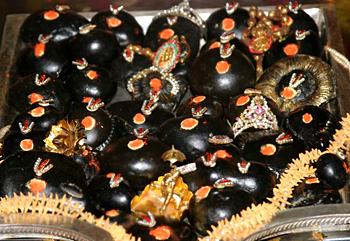 The solar king Bahu was very haughty by character. On being defeated by his enemies, he retired to the forest with his two wives, and died there. His pregnant younger wife, wished to follow her departed husband by committing Sati, was prevented from doing so by sage Aurva. Due to the power of his austerities, sage Aurva also freed the king Bahu from all the sins and helped him seek emancipation.
The solar king Bahu was very haughty by character. On being defeated by his enemies, he retired to the forest with his two wives, and died there. His pregnant younger wife, wished to follow her departed husband by committing Sati, was prevented from doing so by sage Aurva. Due to the power of his austerities, sage Aurva also freed the king Bahu from all the sins and helped him seek emancipation.
There is a chapter on King Virabhadra. One day, while hunting out when he saw a dried-up tank on the peak of Saikata Mountain. He at once ordered his minister Buddhisagara to renovate the tank. Buddhisagara soon carried out the orders and the tank was made useful for all. The king, the minister and those responsible for repairing the tank attained salvation.
A section on the demon Virochana, a performer of dharma, and son of Prahlad has been elucidate. His wife Vishalakshi daily used to invite a Brahmana and worship him. After the killing of Hiranyakashyap, gods were afraid of Virochana also. They went to Vishnu and requested him to kill the devil. Vishnu approached Vishalakshi one morning in the guise of an aged Brahmin. She honoured and offered him a seat, but he never accepted it. He demanded from her a promise to fulfil his desires. She gave the promise, but he was not prepared to believe in the words of a woman. So, she called her husband and he agreed to fulfill his desires. Then Vishnu asked for their lives. Both of them gave their lives with pleasure and achieved liberty.
These Dharmika stories are followed by legends of vratas.
Stories on Vrata in Narada Purana
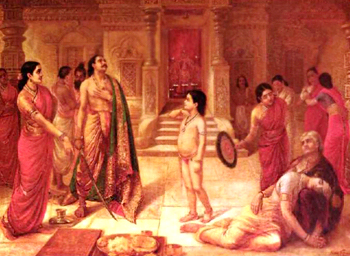 At the outset it starts with King Rukmangada who was a devotee of Vishnu. He strictly observed the Ekadasi vrata and made all his people between the age of eight and eighty-five follow this. Consequently, nobody went to Yamaloka. Yama together with sage informed this to Brahma. To break this vrata, Brahma created Mohini, a very beautiful lady, and after thoroughly instructing, sent her to Mt. Mandara. One day, Rukmangada was out hunting. After having a discussion with Yamadeva, he reached Mt.Mandara. There he saw Mohini, worshipping the Shivalinga, singing sweet songs. He was attracted by her and wished to get married to her. On her insistence, Rukmangada promised her that he would fulfil her desire asked for at any moment; according to the rules laid down by the Griha Sutras tied the knot. There is an incident of how a Brahmin woman tried to bring her husband under her control. For committing evil deeds against her husband she became a house lizard. King Rukmangada helped it attain salvation by giving a portion of the merit of his Sravana Dvadasi vrata.
At the outset it starts with King Rukmangada who was a devotee of Vishnu. He strictly observed the Ekadasi vrata and made all his people between the age of eight and eighty-five follow this. Consequently, nobody went to Yamaloka. Yama together with sage informed this to Brahma. To break this vrata, Brahma created Mohini, a very beautiful lady, and after thoroughly instructing, sent her to Mt. Mandara. One day, Rukmangada was out hunting. After having a discussion with Yamadeva, he reached Mt.Mandara. There he saw Mohini, worshipping the Shivalinga, singing sweet songs. He was attracted by her and wished to get married to her. On her insistence, Rukmangada promised her that he would fulfil her desire asked for at any moment; according to the rules laid down by the Griha Sutras tied the knot. There is an incident of how a Brahmin woman tried to bring her husband under her control. For committing evil deeds against her husband she became a house lizard. King Rukmangada helped it attain salvation by giving a portion of the merit of his Sravana Dvadasi vrata.
Stories of Tirthas in Narada Purana
Numerous tales on places of pilgrimage has been explicated. After Bahu`s death, his widows took shelter with sage Aurva. The younger was pregnant; the elder one was envious of her and poisoned her to death. Due to sage Aurva blessings a son with poison was born to her, who was named Sagara. On coming to know the past history of his father, he decided to take revenge against the kings. He destroyed the enemies. Sagara married the daughters of king Virabhadra - Kesini and Sumati. Kesini gave birth to a son named Asamanja and Sumati to sixty thousand sons. The gods approached Kapila as they could not with stand the torture of these sons. Later on, Amsuman, the grandson of Sagara, was blessed by Kapila that his ancestors would attain salvation, when Bhagiratha would make Ganga flow on the earth. The grandson of Amsuman, Bhagiratha meditated on Narayana and Paramesvara and brought down Ganga.
An incident related to Kasi has been unfolded here. Vishnu`s residence was Kasi. Once Shiva went to Lord Brahma who was reciting the Veda. Shiva cut off the fifth face of Brahma with his nail as it looked arrogant. However, he was unable to separate Brahma`s skull from his hand. Shiva asked Vishnu for help as the sin of Brahmahatya made him anxious. Siva made a pilgrimage, visited holy places and washed his hand in the holy tanks as per the advice of Vishnu. When he begged for alms at Badarikasrama Shiva caught Vishnu`s hand while he was offering and it was pricked by his trishul. Blood flowed from Vishnu`s hand in three different flows. His sin of Brahmahatya was eased when he entered the Vishnu temple at Kasi.
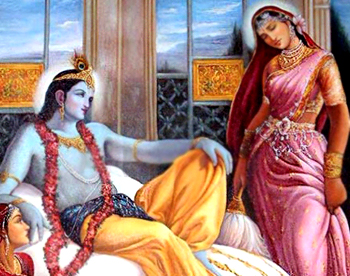 Then there is a story of Lord Krishna, residing in Gokula who would take incarnation as the son of Vasudeva and would go to Nanda through fear of Kansa. There he would destroy the demons like Putana and Vatsa .He would kill some other demons and would destroy the ego of Brahma, Indra, Varuna, the sons of Kubera and others. In Mathura, he would break the bow and would kill the elephant Kuvalaygpida, the athletes and also his uncle Kansa. He would release his parents after that from prison. Subsequently he would stay at Dwarka. He would marry Rukmini, Satyabhama and sixteen thousand other maidens after destroying Bhaurna. He would also kill Paundraka, Sisupala, and many warriors in the battle of the Kauravas and the Pandavas. He would also make the Yadavas squabble among themselves which would lead to complete devastation. He would go to Vaikuntha with his followers in the end. This is followed by the story on Pushkara Island.
Then there is a story of Lord Krishna, residing in Gokula who would take incarnation as the son of Vasudeva and would go to Nanda through fear of Kansa. There he would destroy the demons like Putana and Vatsa .He would kill some other demons and would destroy the ego of Brahma, Indra, Varuna, the sons of Kubera and others. In Mathura, he would break the bow and would kill the elephant Kuvalaygpida, the athletes and also his uncle Kansa. He would release his parents after that from prison. Subsequently he would stay at Dwarka. He would marry Rukmini, Satyabhama and sixteen thousand other maidens after destroying Bhaurna. He would also kill Paundraka, Sisupala, and many warriors in the battle of the Kauravas and the Pandavas. He would also make the Yadavas squabble among themselves which would lead to complete devastation. He would go to Vaikuntha with his followers in the end. This is followed by the story on Pushkara Island.
Biography of Suka
Ved Vyas wished for a learned son so he performed a penance on the peak of the Mt. Mahameru. He was granted his desire as lord was pleased with him. Vyasa came across a beautiful Apsara while rubbing sticks for fire. He lost his command, his semen fell on the stick and Suka was born. Suka acquainted the knowledge of all Vedas and other religious texts. Vyasa with his son Suka practiced meditation. They heard a voice asking them to deliver the Vedas. While doing so a storm occurred. Vyasa told his son to discontinue the recitation as it was a holiday. Then he left for the Ganga. Suka was explained by Sanatkumara the sufferings faced by those living in the mortal world and also taught him the Moksha shastra. Suka left for the Mt. Kailasa. Early morning, facing the rising Sun, he went up to the sky crossed the mountain peaks, flew up. When Vyasa was not able to track Suka, he performed sacrament along with Suka. He viewed the entire planet standing in the air. As per Narayana`s directions he went to his father.
A conclusion can be drawn that these short narrations are of great implication as it stresses on the importance of moksha achievement. In fact all the stories of different sections lead to salvation attainment being the absolute motivation in life.












